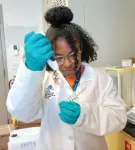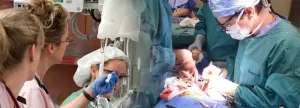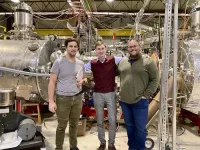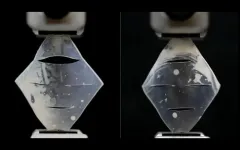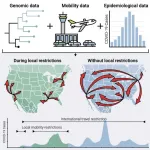Wild birds can disseminate infectious virus particles that spread avian diseases, especially highly pathogenic avian influenza, also known as “bird flu.” While the risk is very low, bird-to-bird and bird-to-human transmission is possible in highly populated areas like New York City, which features 50,000 acres of green spaces and an abundance of wildlife. Surveillance and virus species identification are vital to prepare for and prevent a possible future pandemic, and to identify the types of viruses that may be harmful to humans and other birds.
Established in 2020, the program is a collaboration between BioBus, a science education nonprofit known for its mobile laboratories that bring science to students; Wild Bird Fund, a wildlife rehabilitation center; and Icahn Mount Sinai. Through this program, the students learn lab and research skills, practice science communications, and take steps to become the next generation of problem-solvers.
The newly awarded Science Education Partnership Award (SEPA) grant will support the Virus Hunters program, which empowers students to help prevent the next pandemic by turning them into virus detectives who conduct surveillance work. They begin their research by safely collecting bird fecal samples at urban parks and natural areas. The students then process the samples in the lab of Florian Krammer, PhD, Mount Sinai Professor in Vaccinology and a globally recognized leader in influenza research, including the development of novel vaccines and therapeutics. The lab work involves screening the collected fecal samples and analyzing the genomes of identified viruses. No live viruses will be handled; only their non-infectious genomes will be detected and analyzed. According to Dr. Krammer, birds are key to finding out which influenza and other avian viruses are circulating in the New York City area as well as important for understanding which ones are dangerous to both other birds and humans, and which are not.
“Data generated from the pilot phase of the New York City Virus Hunters program has already resulted in peer-reviewed scientific publication and entries of the first two avian paramyxoviruses ever identified in New York City’s pigeons,” said Dr. Krammer, Principal Investigator of the Virus Hunters program. “This new, five-year SEPA grant will enable us to extend and broaden this citizen science initiative so we can recruit and support many more middle and high school students to participate at large-scale sampling events. This allows us to expand the number of biospecimens we’re able to collect and analyze.”
BioBus has an established network of more than 800 New York City schools and community-based organizations serving primarily diverse student populations that are historically underrepresented in science, technology, engineering and math. Through this new SEPA grant, Virus Hunters program leaders will refine their existing program infrastructure and expand the partnerships between organizations that currently participate to the New York City school system.
Over the course of the five-year program, Virus Hunters leaders envision recruiting and training 100 teachers and 6,000 students who will participate in sampling events across New York City. In addition, 25 high school students will partake in the initiative as paid Junior Research Scientist interns, supported by a network of BioBus and Mount Sinai mentors to spearhead the initiative. They will screen collected samples; perform nucleic acid extractions, sequencing, and sequence analysis; perform phylogenetic analysis, and get trained in general virology by expert mentors at Icahn Mount Sinai. Organizers hope some will become the next generation of leading virologists.
“Young people are smart and capable of making meaningful contributions to science when given the opportunity to engage in our scientific community, a community which is in dire need of a new generation of diverse and enthusiastic voices,” said Christine Marizzi, PhD, Director of Community Science at BioBus, Adjunct Assistant Professor of Microbiology at Icahn Mount Sinai and Co-Principal Investigator of the Virus Hunters program. “Throughout the program, students build their own identity as scientists, gaining both a sense of belonging in the scientific community and valuable experience as they pursue further science education and careers. We are thrilled and grateful to be able to expand our program through this new SEPA grant so that we can empower even more youth to help us participate in research that will make the Big Apple safer.”
This project is funded by a SEPA grant from the National Institutes of General Medical Sciences at the NIH. The content is solely the responsibility of the authors and does not necessarily represent the official views of the National Institutes of Health.
About the Mount Sinai Health System
Mount Sinai Health System is one of the largest academic medical systems in the New York metro area, with more than 43,000 employees working across eight hospitals, more than 400 outpatient practices, more than 300 labs, a school of nursing, and a leading school of medicine and graduate education. Mount Sinai advances health for all people, everywhere, by taking on the most complex health care challenges of our time—discovering and applying new scientific learning and knowledge; developing safer, more effective treatments; educating the next generation of medical leaders and innovators; and supporting local communities by delivering high-quality care to all who need it. Through the integration of its hospitals, labs, and schools, Mount Sinai offers comprehensive health care solutions from birth through geriatrics, leveraging innovative approaches such as artificial intelligence and informatics while keeping patients’ medical and emotional needs at the center of all treatment. The Health System includes approximately 7,400 primary and specialty care physicians; 13 joint-venture outpatient surgery centers throughout the five boroughs of New York City, Westchester, Long Island, and Florida; and more than 30 affiliated community health centers. Hospitals within the System are consistently ranked by Newsweek’s® “The World’s Best Smart Hospitals, Best in State Hospitals, World Best Hospitals and Best Specialty Hospitals” and by U.S. News & World Report's® “Best Hospitals” and “Best Children’s Hospitals.” The Mount Sinai Hospital is on the U.S. News & World Report® “Best Hospitals” Honor Roll for 2023-2024.
###
END
